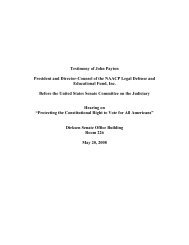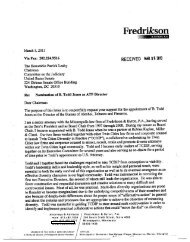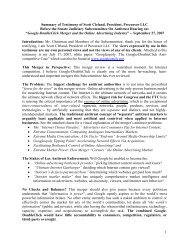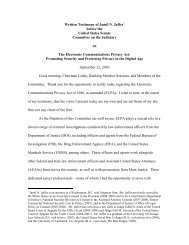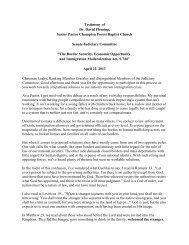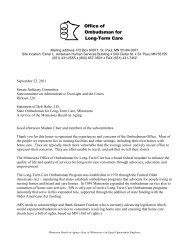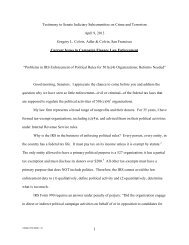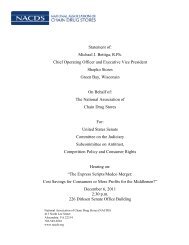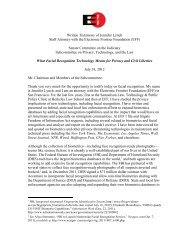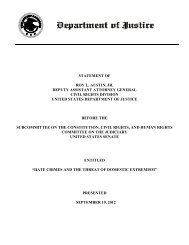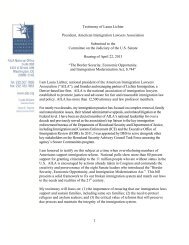Untitled - Senate Judiciary Committee
Untitled - Senate Judiciary Committee
Untitled - Senate Judiciary Committee
You also want an ePaper? Increase the reach of your titles
YUMPU automatically turns print PDFs into web optimized ePapers that Google loves.
I<br />
I<br />
I<br />
t<br />
I I<br />
.I<br />
I<br />
i<br />
I<br />
i<br />
I<br />
I<br />
I<br />
I<br />
I<br />
I I<br />
AUTOMATIC CYCLE-CONTROLLER--OPERATION<br />
ELECTRIC-SIGNAL ACTUATED<br />
The function of the automatic cycle controller is to start, regulate, and end the regeneration of<br />
a softener or dealkalizer, or the backwash of a filter. The complete cycle controller consists of<br />
two subassemblies--an electrical timing mechanism and a motor-driven pilot valve. This cycle<br />
controller is actuated by an electric signal from an automatic-reset meter, hardness monitor, or<br />
other signal-producing device designed for this use. A built-in push-button switch caqi be used to’<br />
initiate regeneration, if desired. In an emergency, the cycle controller can be operated manually<br />
by turning the Position Dial by hand and timing each step.<br />
THEORY OF OPERATION<br />
TE RMINAL<br />
BLOCK<br />
INDICATO LIGHT<br />
In operation, the electric timing mechanism is actuated by an electric sgn&l froma automatic:<br />
reset meter or hardness monitor, and the cycle adjustment knob begins to rotate slowly in a<br />
clockwise direction. This rotation closesa switch which energizes the pilot drive motor. The pilotdrive<br />
motor will rotate the pilot valveclockwisei90 when at this point a micro-switch opens,<br />
stopping the pilot-drive motor. The cycle-adjustment knob continues to rotate.<br />
The pilot valve, which is urer,pressure, is.connected to the multiport control valve by a series of<br />
tubes. The rotation of the pilot vents some of the diaphragm ports, allowing them to open while<br />
pressuring others and forcing them closed. This shifts the multiport valve from the SERVlCE<br />
(No.l) position to BACKWASH (No. 2). The setting on the cycle-adjustment knob determines<br />
the length of the BACKWASH cycle.<br />
After this period, the cycle-adjustment knob closes a second switch which energizes the pilotdrive<br />
motor. The pilot valve will again rotate clockwise 90 where a micro-switch stops the<br />
pilot-drive motor. This second rotation of the pilot valve opens and closes a different series of<br />
valve ports, and the multiport valve shifts from the BACKWASH (No. 2) position to BRINE/<br />
RINSE (No. 3).<br />
After the BRINE/RINSE cycle, the cycle-adjustment knob closes a third switch and energizes<br />
the pil0t-drive motor. The pilot valve will rotate clockwise 90 where a micro-switch opens,<br />
stopping the pilot-drive motor. This rotation of the. pilot valve causes a third series of valve<br />
ports to open and close, shifting the multiport valve from the BRINE/RINSE (No. 3).position<br />
to FLUSH (No. 4).<br />
When the FLUSH cycle has been completed, the cycle-adjustment knob closes a fourth switch,<br />
energizing the pilot-drive motor. The pilot valve will again rotate clockwise 90 and shut off.<br />
At this point, a different series of valve-ports will cpen and close, shifting the multiport valve<br />
from the FLUSH (No. 4) position to SERVICE (No. 1). The cycle contoller will remain in<br />
the SERVICE position until the next scheduled cycle or until manually started by an operator.<br />
Throughout the regeneration, the position of the multiport valve is shown on the Position<br />
Dial located at the rear of the pilot valve.



